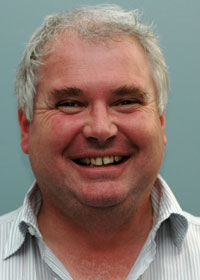|
|
NAME
|
Andrew Young
Director,
Centre for Australian National Biodiversity Research
Ph.D., Carleton University, Canada, 1993
|

|
|
CONTACT
|
Phone (+61) 02 6246 5318
Fax: (+61) 02 6246 5000
E-mail: Andrew.Young@csiro.au
Centre for Australian National Biodiversity Research
CSIRO Plant Industry
GPO Box 1600
Canberra ACT 2601
AUSTRALIA
|
|
RESEARCH INTERESTS
|
My research addresses plant population genetics and ecology. I
am particularly interested in how genetic processes interact with
demography to influence population viability, particularly in fragmented
populations. Project areas include basic research on effects of
genetically controlled self-incompatibility systems on mate availability,
the role of inbreeding in determining the viability of fragmented
populations, genetics and ecology of rare and endangered species,
provenance studies of common shrubs and trees for restoration and
ecological risk assessment of GMOs. My research employs a broad
range of techniques including the use of molecular genetic markers,
demographic monitoring, growth experiments and simulation modeling.
I also teach conservation genetics at in the School of Resource
and Environmental Management at the Australian National University,
where I am an Adjunct Senior Lecturer.
|
|
SELECTED PUBLICATIONS
|
-
Young, A., Boyle, T. and Brown, A. 1996. he population
genetic consequences of habitat fragmentation for plants. Trends
in Ecology and Evolution, 11: 413-418.
-
Young, A.G. and Brown, A.H.D. 1998. Comparative analysis
of the mating system of the rare woodland shrub Daviesia
suaveolens and its common congener D. mimosoides.
Heredity, 80:374-381.
-
Young, A.G. Brown, A.H.D. and Zich, F.C. 1999.Genetic
structure of fragmented populations of the endangered grassland
daisy Rutidosis leptorrhynchoides. Conservation Biology,
13:256-265.
-
Young, A.G. and Brown, A.H.D. 1999. Paternal bottlenecks
in fragmented populations of the endangered grassland daisy
Rutidosis leptorrhynchoides Genetical Research, 73:111-117.
-
Young, A.G. and Murray, B.G. 2000. Genetic bottlenecks
and dysgenic gene flow in re-established populations of the
endangered grassland daisy Rutidosis leptorrhynchoides.
Australian Journal of Botany, 48:409-416.
-
Buza, L., Young, A. and Thrall. P.H. .2000. Genetic
erosion, inbreeding and reduced fitness in fragmented populations
of the tetraploid pea Swainsona recta. Biological Conservation.93:
177-186.
-
Schmidt-Adam, G. Young, A.G. and Murray, B.G.M. 2000.
Low outcrossing rates and shift in pollinators in New Zealand
Pohutukawa (Metrosideros excelsa) (Myrtaceae). American
Journal of Botany 87:1265-1272.
-
Young, A.G., Millar. C., Gregory, E.A. and Langston,
A. 2000. Sporophytic self-incompatibility in diploid and tetraploid
races of Rutidosis leptorrhynchoides. Australian Journal
of Botany. 48:667-672.
-
Young, A.G., Brown, A.H.D., Murray, B.G., Thrall, P.H.
and Miller, C.H. 2000. Genetic erosion, restricted mating and
reduced viability in fragmented populations of the endangered
grassland herb: Rutidosis leptorrhynchoides. In: A.G.Young
and G.M. Clarke (eds) Genetics, Demography and Viability of
Fragmented Populations. Cambridge University Press. Pp.335-359.
-
Brown, A.H.D. and Young, A.G. 2000. Genetic diversity
in tetraploid populations of the endangered daisy Rutidosis
leptorrhynchoides and implications for its conservation.
Heredity. 85:122-129.
-
Young, A., Boyle, T. and Boshier, D. (eds) (2000) Forest
Conservation Genetics: Principles and Practice, CSIRO Publishing.
Pp352.
-
Young, A. and Clarke, G. (eds) (2000) Genetics, Demography
and the Viability of Fragmented Populations, Cambridge University
Press. Pp421.
-
Young, A.G., Schmidt-Adam, G, and Murray, B.G. 2001.
High genetic variation and limited differentiation in remnant
stands of the pohutukawa (Metrosideros excelsa Sol. Ex
Gaertn., Myrtaceae). New Zealand Journal of Botany 39:133-140.
-
Murray B.G. and Young, A.G. 2001. High cytogenetic variation
in the endangered daisy Rutidosis leptorrhynchoides.
Annals of Botany 87:83-90.
-
J. Costin, J.W. Morgan & A.G. Young. 2001. Reproductive
success does not decline in fragmented populations of Leucochrysum
albicans subsp. albicans var. tricolor (Asteraceae).
Biological Conservation. 98:273-284
-
Hoebee, S.E., and Young, A.G. 2001. Low neighbourhood
size and high interpopulation differentiation in the endangered
shrub Grevillea iaspicula McGillivray (Proteaceae). Heredity
86:489-496.
-
Young, A.G., Hill, J.H., Murray, B.G. and Peakall, R.
2002. Mating system, genetic diversity and clonal structure
in the alpine herb Rutidosis leiolepis F. Muell. (Aasteraceae).
Biological Conservation 106:71-78.
-
Wells, G.P. and Young, A.G. In press. Effects of seed
dispersal and clonality on spatial genetic structure in four
populations of Rutidosis leptorrhynchoides with differing
levels of correlated paternity. Genetical Research.
-
Thrall, P.H., Young, A.G. and Hoebee, S.E. In review.
Effects of S allele limitation on viability of plants with varied
ecologies. Conservation Biology
|
|
CURRENT RESEARCH PROJECTS
|
Ecology and Genetics of Remnant Vegetation
Ecological Risk Assessment of GMOs
Ecosystem Restoration
Plant-Microbial Associations & Restoration
Ecology
|
|
STUDENTS
|
Carter PhD (University of New England) Reproductive Ecology of
an Endangered Species on the Northern Tablelands
Field PhD (University of Wollongong) Hybridsation in Eucalyptus
aggregata
Neal PhD (University of New England) Population genetics of Macadamia
Melinda Pickup PhD (Australian National University) Outbreeding
depression in Rutidosis lepotrrhynchoides
|
|
![An Australian Government Initiative [logo]](/images/austgovt_canbr_90px.gif)

![An Australian Government Initiative [logo]](/images/austgovt_canbr_90px.gif)
